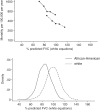The use of ethnically specific norms for ventilatory function in African-American and white populations
- PMID: 22434864
- PMCID: PMC3396311
- DOI: 10.1093/ije/dys011
The use of ethnically specific norms for ventilatory function in African-American and white populations
Abstract
Background: In the USA, different standards are usually set for spirometric values in African-American and white populations. It is unclear to what extent the lower lung function found in African-Americans is 'normal' in the sense of having no adverse consequences.
Methods: African-American and white participants in the Atherosclerosis Risk in Communities (ARIC) limited access data set, from four communities in the USA had spirometric testing at baseline beginning in 1986 and were followed up to assess survival to the end of 2002.
Results: Forced Expiratory Volume in 1 s (FEV(1)) and Forced Vital Capacity (FVC) were lower in the African-American than the white sample both for men and women and adjustment for potential confounders had little effect on the estimated difference {difference in FVC after adjustment: men, -0.68 l [95% confidence interval (95% CI) -0.75 to -0.61]; women, -0.41 l (95%CI -0.45 to -0.36)}. The FEV(1)/FVC ratio was slightly greater among African-American than white participants [difference: men, 1.5% (95%CI 0.7-2.1); women, 1.7% (95%CI 1.1-2.2)]. After adjustment for age and height, survival was similar in each ethnic group for any given level of FVC before and after adjustment for potential confounders. The hazard ratio for African-American compared with white participants was 1.24 for men (95% CI 0.91-1.69) and 0.96 for women (95% CI 0.66-1.38).
Conclusions: A given FVC has the same prognostic significance for 'normal' African-American and white participants. It is inappropriate to use ethnic norms when assessing prognosis.
Figures




Comment in
-
Ethnically specific norms for ventilatory function.Int J Epidemiol. 2012 Oct;41(5):1490; author reply 1491-2. doi: 10.1093/ije/dys153. Int J Epidemiol. 2012. PMID: 23045209 No abstract available.

